Monthly Updates on Recent Books in the History of Christianity
To raise awareness of recent books in the history of Christianity, the editorial staff of Church History: Studies in Christianity and Culture highlights each month a list of 10-15 books in diverse periods and geographical regions that we hope will be of interest to our members. We include here below the 47th monthly list, chosen by our staff, with excerpts from the publishers’ blurbs.
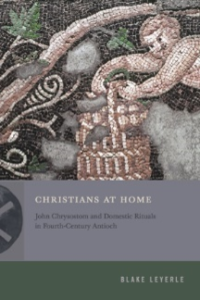
Blake Leyerle, Christians at Home: John Chrysostom and Domestic Rituals in Fourth-Century Antioch. 2024
Pennsylvania State University Press
What did it mean for ordinary believers to live a Christian life in late antiquity? In Christians at Home, Blake Leyerle explores this question through the writings, teachings, and reception of John Chrysostom—a priest of Antioch who went on to become the bishop of Constantinople in AD 397.
Through elaborate spatial and ritual recommendations, Chrysostom advised listeners to turn their houses into churches. Influenced by New Testament descriptions of the Pauline communities, he preached that prayer and chant, scriptural discussion and hospitality, and even domestic furnishings would have a transformational effect on a home’s inhabitants. But as Leyerle shows, Chrysostom’s lay listeners had different views. They were focused not on personal ethical change or on the afterlife but on the immediate, tangible needs of their households. They were committed to Christianity and defended the legitimacy of their views, even citing precedents from scripture in support of their practices
By reading these perspectives on early Christian life through one another, Leyerle clarifies the points of disagreement between Chrysostom and his lay listeners and, at the same time, highlights their shared understanding. For both the preacher and his congregations, the household formed a vital ritual arena, and lived religion was necessarily rooted in practice. Elegantly written and convincingly argued, this study will appeal to scholars of theology, classics, and the history of Christianity in particular.
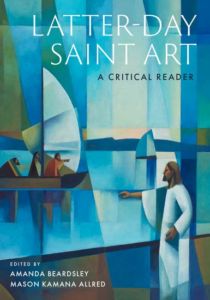
Amanda Beardsley and Mason Allred, eds. Latter-day Saint Art: A Critical Reader. 2024
With over twenty chapters treating different time periods, movements, and media, this critical reader provides the most comprehensive scholarly engagement with Mormon art and its history to date from a range of scholars from different backgrounds and disciplines. Trained in art history, cultural studies, media studies, history, and religious studies, the authors bring fresh insights and objects into view. The resulting picture of Mormon art is fascinating, enlightening, and visually stunning. Treating topics from landscape painting, political cartoons, and photography to hair art, film, and contemporary installations, the volume can serve as a university course reader or as an unprecedented deep dive into Mormon art for general readers and scholars alike.
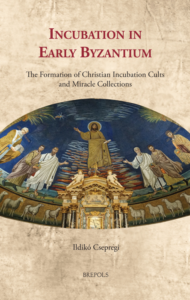
Ildikó Csepregi, Incubation in Early Byzantium: The Formation of Christian Incubation Cults and Miracle Collections. 2024
Incubation (temple sleep) was a well-known ritual in the Near East and became increasingly popular in Classical and Hellenistic Greece, becoming attached to Asclepius and other divinities. It flourished in the Eastern Mediterranean, where it was encountered by the emergent Christianity. Temple sleep was so widespread that it was impossible to ban. The Christianization of the incubation ritual was thus a detailed and lengthy (but successful) process that encompassed several aspects of the Church’s self-definition, including important social and theological issues of the era. The list of relevant issues is extensive: the fate of Greek temples and the reinterpretation of sacred space, confronting Hippocratic medicine, and the learned Greek intelligentsia. Since disease and a search for cure is a ubiquitous human need, the early Church embraced a healing ministry, in secular terms as well as in ritual healing. Incubation records show how the Church viewed dreams, conversion, or the notions of magic and divination. All these come within the framework of writing miracles: the transformation of the cult was thus incorporated into standard Church discourse, from ritual practice to proper literary genres.
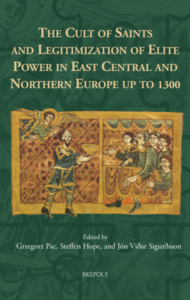
Grzegorz Pac, Steffene Hope, and Jon Vidar Sigurdsson, eds. The Cult of Saints and Legitimization of Elite Power in East Central and Northern Europe up to 1300. 2024
While Northern and East Central Europe are often considered to have been peripheral parts of medieval Latin Christendom, they nevertheless embraced many of the same cultural impulses found in more central areas. Key among these was the way in which social elites, in the first centuries after the introduction of Christianity, recognized the potential to exploit the cult of saints as a way of legitimizing their own social standing. Taking this thematic focus as its starting point, this volume explores the intersection of religion, power, and the reception and development of new impulses from abroad within Northern and East Central Europe. It does so by comparing and contrasting cults that emerged locally with cults that were imported to the region. Through this comparative overview, the chapters of this volume not only contribute to a more nuanced understanding of these outlying regions, but also shed new light on Latin Christian Europe as a whole.

Hunter Price, Sacred Capital: Methodism and Settler Colonialism in the Empire of Liberty. 2024
In the early years of American independence, Methodism emerged as the new republic’s fastest growing religious movement and its largest voluntary association. Following the contours of settler expansion, the Methodist Episcopal Church also quickly became the largest denomination in the early American West. With Sacred Capital, Hunter Price resituates the Methodist Episcopal Church as a settler-colonial institution at the convergence of “the Methodist Age” and Jefferson’s “Empire of Liberty.”
Price offers a novel interpretation of the Methodist Episcopal Church as a network through which mostly white settlers exchanged news of land and jobs and facilitated financial transactions. Benefiting from Indigenous dispossession and removal policies, settlers made selective, strategic use of the sacred and the secular in their day-to-day interactions to advance themselves and their interests. By analyzing how Methodists acted as settlers while identifying as pilgrims, Price illuminates the ways that ordinary white Americans fulfilled Jefferson’s vision of an Empire of Liberty while reinforcing the inequalities at its core.
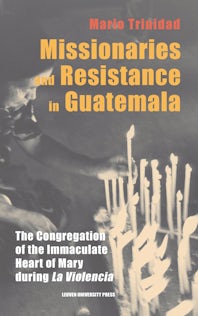
Mario Trinidad, Missionaries and Resistance in Guatemala: The Congregation of the Immaculate Heart of Mary during 'La Violencia.' 2024
Leuven University Press/Cornell
In Guatemala, the 36-year armed conflict from 1960 to 1996 claimed 200,000 lives, over two per cent of the population, and displaced a million more. In the 1970s and the 1980s the widespread and violent repression of social movements fighting for justice and human rights reached unimaginable proportions, involving assassinations, disappearances, and exile. Even parts of the Church, traditionally considered an ally of the powerful and the wealthy, were not spared this fate.
Missionaries and Resistance in Guatemala chronicles the involvement of certain Catholic missionaries in popular and revolutionary movements. Based primarily on their own accounts, it narrates their gradual progression from conservative theological and pastoral practices to radical positions, informed by their solidarity with the poor and a theology of liberation. Their stories are situated in a wider geopolitical and ecclesial context.
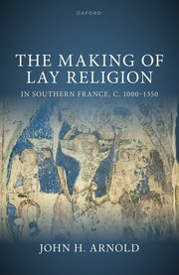
John H. Arnold, The Making of Lay Religion in Southern France, c. 1000-1350. 2024
What was Christianity like for ordinary people between the turn of the millennium and the coming of the Black Death? What changed and what continued, in their experiences, habits, feelings, hopes, and fears? How did they know themselves to be Christians, and indeed to be good Christians? This book answers those questions through a focus on one specific region -- southern France -- across a particularly fraught period of history, one beset by the changes wrought by the Gregorian reforms, the spectre of heresy, the violence of crusade, the coming of inquisition, and the pastoral revolution associated with the Fourth Lateran Council (1215). Using an array of different historical documents, John H. Arnold explores the material contexts of Christian worship from the eleventh through to the fourteenth centuries, the shifting episcopal expectations of the ordinary laity, the changes wrought through wider socioeconomic developments, and periods of sharp inflection brought by the Albigensian crusade and its aftermath. Throughout, the book explores the complex spectrum of lay piety, finding enthusiasms and doubts, faith and scepticism, agency and negotiation. It explores not just developments in the content of faith for the laity but the very dynamics of belief as a lived experience. We are shown how across these key centuries Christianity developed in its external practices, but also via inculcating a more interiorized and affective mode of belief; and thus, it is argued, it can be said to have become truly a 'religion' -- a structured, demanding, and rewarding faith -- for the many and not just the few.
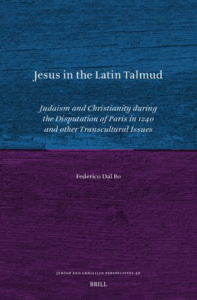
Federico Dal Bo, Jesus in the Latin Talmud: Judaism and Christianity during the Disputation of Paris in 1240 and Other Transcultural Issues. 2024
Between 1238 and 1239, the notorious Jewish convert Nicholas Donin persuaded Pope Gregory IX to condemn the Talmud, prompting European kings to intervene. Only King Louis IX of France agreed to a public disputation in 1240, subjecting the Talmud to scrutiny. Prominent Jewish and Christian figures debated Jesus in the Talmud. The Talmud was condemned between 1241 and 1242, but the Church of Paris, responding to Jewish pleas, allowed an appeal. Scholars were commissioned to translate portions of the Talmud, resulting in two anthologies titled Extractiones de Talmud--the first translation of this work. Still, this did not save the Talmud from burning.
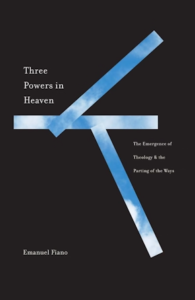
Emanuel Fiano, Three Powers in Heaven: The Emergence of Theology and the Parting of the Ways. 2023
How, when, and why did Christianity and Judaism diverge into separate religions? Emanuel Fiano reinterprets the parting of the ways between Jews and Christians as a split between two intellectual traditions, a split that emerged within the context of ancient debates about Jesus’s relationship to God and the world.
Fiano explores how Christianity moved away from Judaism through the development of new practices for religious inquiry. By demonstrating that the constitution of communal borders coincided with the elaboration of different methods for producing religious knowledge, the author shows that Christian theological controversies, often thought to teach us nothing beyond the history of dogma, can cast light on the broader religious landscape of late antiquity. Three Powers in Heaven thus marks not only a historical but also a methodological intervention in the study of the parting of the ways and in scholarship on ancient religion.
Daniel Maul, The Politics of Service: American Quakers and the Emergence of International Humanitarian Aid 1917–1945. 2024
This book provides the first comprehensive history of the American Friends Service Committee (AFSC), the central aid agency of the Religious Society of Friends or Quakers, from 1917 to 1945. Implying a thoroughly transnational approach, it sheds a light on the important role American Quakers played in the emergence of a humanitarian sector both within the USA and beyond. Through the Quaker lens the book addresses important tensions inherent to the history of humanitarianism in the 20th century: Following the AFSCs aid operations from the First World War, through post-war Germany and Soviet Russia to the Spanish Civil War and into the Second World War, it deals with the AFSC’s conflicting roles as a specifically American aid organization on the one hand and its position within transnational religious and pacifist networks on the other and it opens a window to processes of professionalization, the development of a humanitarian “market place” and the complex relationship of religious and secular strands in the history of international relief.
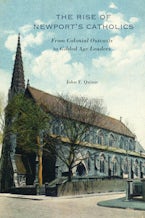
John F. Quinn, The Rise of Newport’s Catholics: From Colonial Outcasts to Gilded Age Leaders. 2024
University of Massachusetts Press
Nineteenth-century New England was a hostile place for Catholics. In Massachusetts a mob torched a convent; in Maine a priest was tarred and feathered; and Rhode Island elected an anti-Catholic Know Nothing governor. “No Irish Need Apply" signs were common.
Newport was different. It was a religiously diverse and tolerant city that welcomed Catholic French troops during the American Revolution. Later, as it became the favored summer retreat for America's Protestant social elite, Irish Catholics arrived to work in construction jobs, the tourist economy, and the grand Gilded Age cottages. By the end of the century, Newport's Catholic community was flourishing. Moneyed Catholics acquired their own mansions, an Irish Catholic was mayor, and prominent Protestants were helping Catholic neighbors establish new schools and churches. In this deeply researched study, John F. Quinn delves into this rich Catholic history to discover why nineteenth-century Newport was particularly religiously tolerant and accepting.
Finally, for staying up-to-date on the latest titles in all fields, we recommend regularly perusing New Books Network and its "New Books in Christian Studies” page. These pages are updated regularly.
